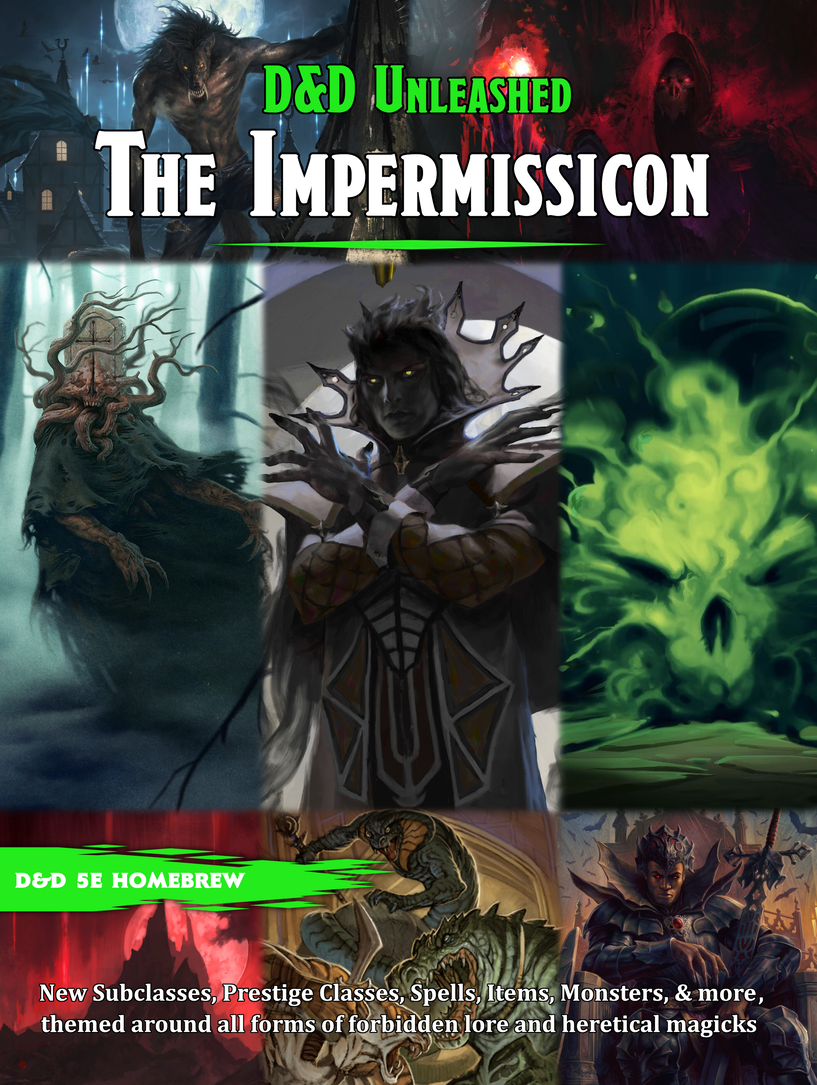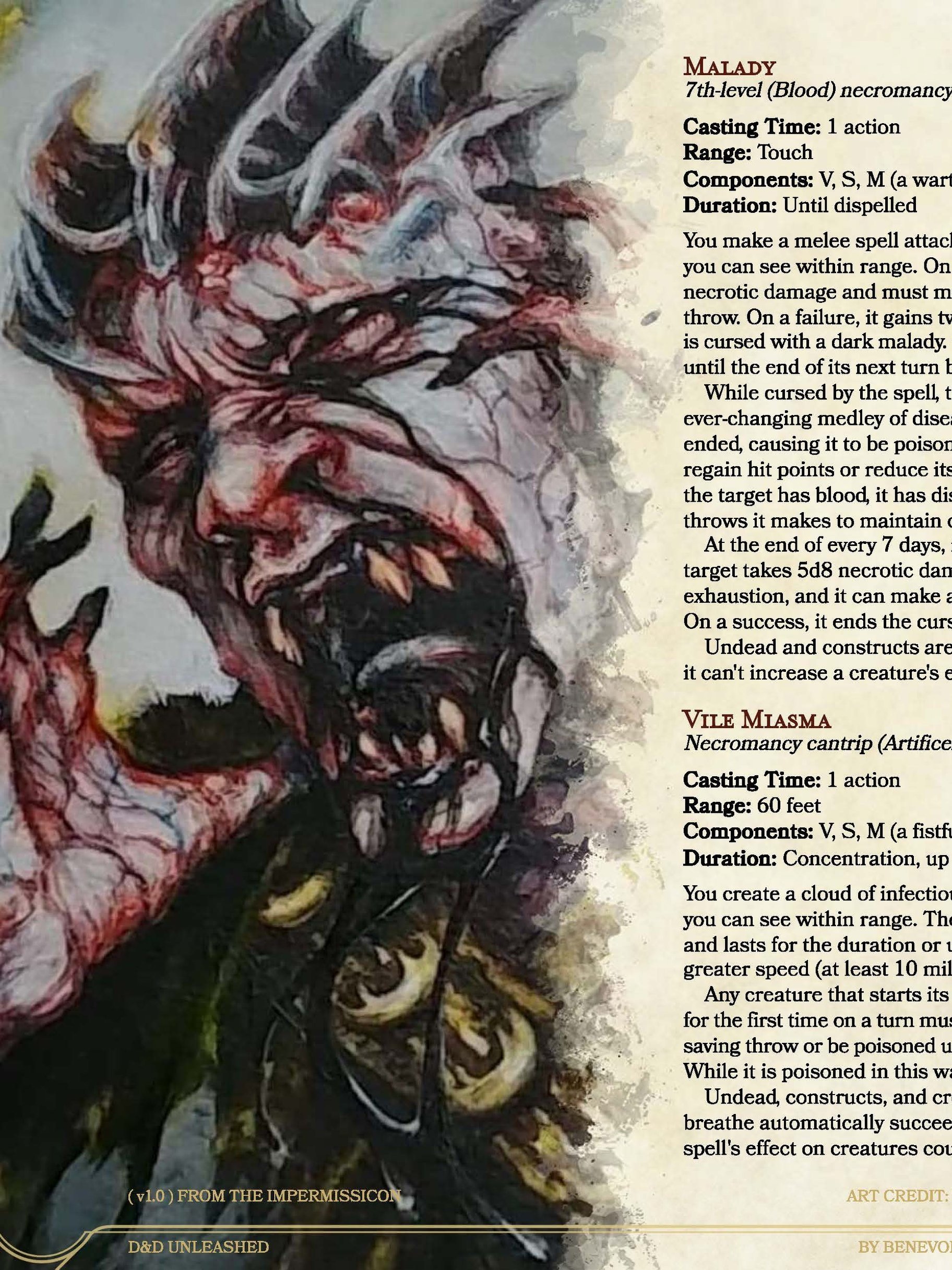New Spells: Offensive Necromancies
The most updated version of this content can be found within The Impermissicon, a free 254-page compendium that you can download right here, filled with 24 subclasses, 3 prestige classes, 2 feats, 107 spells, 118 spell variants, 91 monsters, 61 magic items, 24 poisons, 23 diseases, and even more goodies themed around lycanthropes, vampires, and forbidden magic for both players and DMs!
“Sticks and stones may break my bones, but necromancy can break them to dust.”
PDF Link | D&D Beyond Links: Bone Break, Heart Break
Art Credit: https://morbidfantasy21.tumblr.com/post/141191431119/demon-concept
It’s October, and as we approach Halloween, we’ve got even more spooky and horror-themed D&D content. For example, today’s preview is from The Impermissicon, and it focuses on grisly necromancies that really hurt! At some spell levels, necromancers in 5th edition suffer from a dearth of offensive options that focus their power into damage-dealing. For that niche, these two spells both bring single-target damage themed around harming specific body parts, in a similar way that blindness/deafness harms one or two specific senses. Bone break is the new spell at 2nd-level that focuses dark magic into snapping the target’s bones, and all the way up at 8th-level is heart break, a cheekily-named spell that terrifyingly rips a target’s heart (or another organ that it needs to live) out of its body if it deals enough damage.
Bone break is a debuffing necromancy that also fills a troublesome niche. Necromancers often suffer when forced to battle undead, as many necromancies can’t affect undead or constructs, even though it feels intuitive that a necromancer should have an easier time dismantling enemy undead. This spell provides necromancers as early as level 3 with a reliable way to truly harm most undead while knocking them to the ground, hurting skeletons (with their vulnerability to bludgeoning damage) more than any other kind of undead. What else did you expect from a spell named bone break? And when the necromancer faces targets that aren’t undead, this spell still has a use. While Constitution isn’t the best saving throw to target, the debilitating effects of the spell will still put a damper on any opponent’s offensive and crush them with bone-cracking damage at the same time. This spell’s damage is slightly low for a 2nd-level spell that only damages one target, but hindering effects and potency against undead turn it into a staple spell that many necromancers will want to keep in their arsenal!
Heart break should be familiar to anyone that’s watched Indiana Jones and the Temple of Doom. This necromancy is also a Blood spell, which means it works with some blood magic feats, features, and items to activate unique effects. It also means that the spell cares in some way whether a creature has blood — sometimes a target, sometimes the caster themselves. Unlike some Blood spells that require the target to have blood, heart break can still be used on targets that don’t have blood. Even constructs like an Iron Golem aren’t immune to the basic effects of heart break’s spell attacks, much like the inflict wounds spell, which is also a melee spell attack. This spell works much like soul blade or flame blade in the way the attack can be repeated to get more sustained damage out of the same spell slot. The bonus effect that the spell provides against targets with blood usually serves a role-playing purpose, such as earning a terrifying reputation among the witnesses or arranging a hostage situation to quickly put an end to hostilities. There are also situations where a DM may leave opponents that might be healed at 0 hit points instead of killing them outright, and heart break will prevent that and make the combat that much easier — if the target fits the blood spell’s special criteria. As a DM, heart break can be applied to powerful villainous spellcasters to make for a particularly tense and heart-pounding combat. Players will long-remember “that one D&D combat when our hearts got briefly ripped out of our bodies!”
PDF Link | D&D Beyond Links: Bone Break, Heart Break









